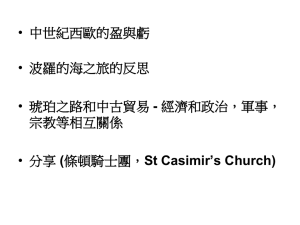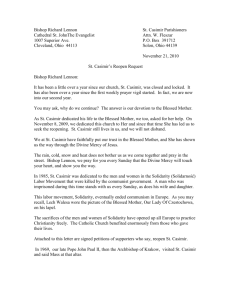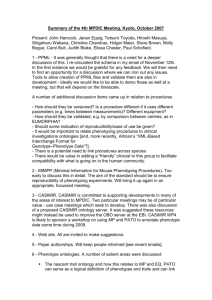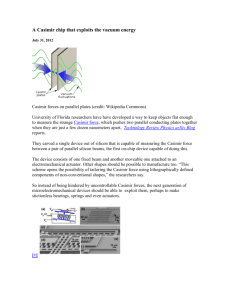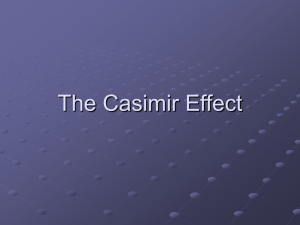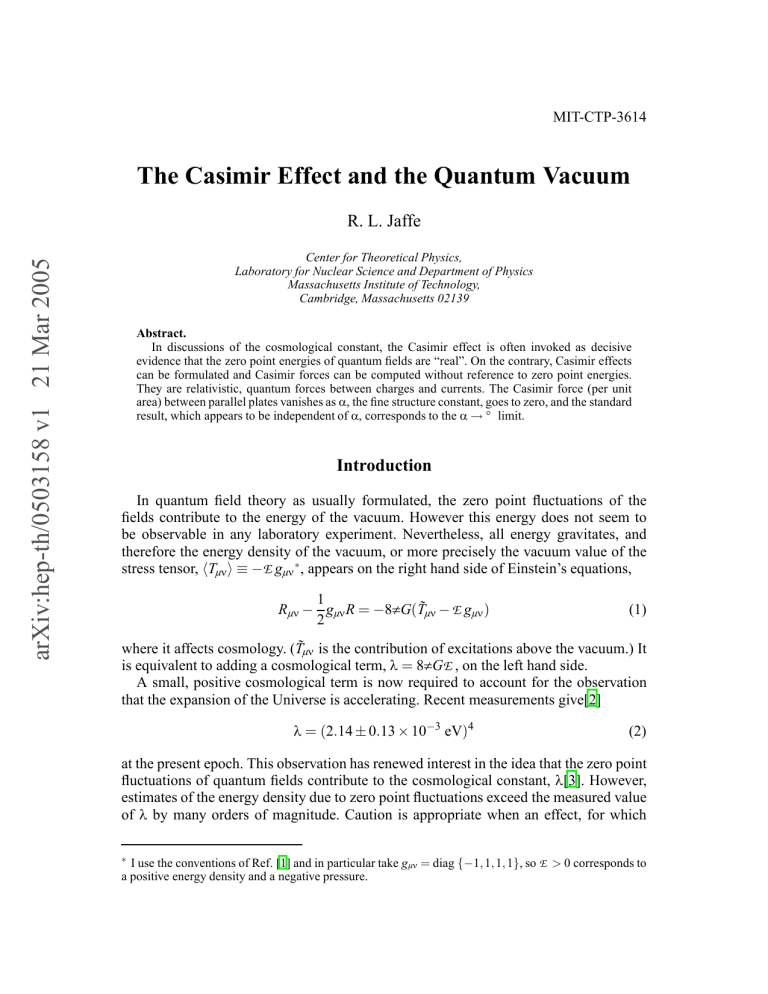
MIT-CTP-3614
The Casimir Effect and the Quantum Vacuum
arXiv:hep-th/0503158 v1 21 Mar 2005
R. L. Jaffe
Center for Theoretical Physics,
Laboratory for Nuclear Science and Department of Physics
Massachusetts Institute of Technology,
Cambridge, Massachusetts 02139
Abstract.
In discussions of the cosmological constant, the Casimir effect is often invoked as decisive
evidence that the zero point energies of quantum fields are “real”. On the contrary, Casimir effects
can be formulated and Casimir forces can be computed without reference to zero point energies.
They are relativistic, quantum forces between charges and currents. The Casimir force (per unit
area) between parallel plates vanishes as α, the fine structure constant, goes to zero, and the standard
result, which appears to be independent of α, corresponds to the α → ∞ limit.
Introduction
In quantum field theory as usually formulated, the zero point fluctuations of the
fields contribute to the energy of the vacuum. However this energy does not seem to
be observable in any laboratory experiment. Nevertheless, all energy gravitates, and
therefore the energy density of the vacuum, or more precisely the vacuum value of the
stress tensor, hTµν i ≡ −E gµν ∗ , appears on the right hand side of Einstein’s equations,
1
Rµν − gµν R = −8πG(T̃µν − E gµν )
2
(1)
where it affects cosmology. (T̃µν is the contribution of excitations above the vacuum.) It
is equivalent to adding a cosmological term, λ = 8πGE , on the left hand side.
A small, positive cosmological term is now required to account for the observation
that the expansion of the Universe is accelerating. Recent measurements give[2]
λ = (2.14 ± 0.13 × 10−3 eV)4
(2)
at the present epoch. This observation has renewed interest in the idea that the zero point
fluctuations of quantum fields contribute to the cosmological constant, λ[3]. However,
estimates of the energy density due to zero point fluctuations exceed the measured value
of λ by many orders of magnitude. Caution is appropriate when an effect, for which
∗
I use the conventions of Ref. [1] and in particular take gµν = diag {−1, 1, 1, 1}, so E > 0 corresponds to
a positive energy density and a negative pressure.
there is no direct experimental evidence, is the source of a huge discrepancy between
theory and experiment!
As evidence of the “reality” of the quantum fluctuations of fields in the vacuum,
theorists often point to the Casimir effect [6]. For example, Weinberg in his introduction
to the cosmological constant problem, writes[5],
“Perhaps surprisingly, it was along time before particle physicists began seriously to worry about [quantum zero point fluctuation contributions to λ]
despite the demonstration in the Casimir effect of the reality of zero-point
energies.”
More recent examples can be found in the widely read reviews by Carroll[7],
“ ... And the vacuum fluctuations themselves are very real, as evidenced by the
Casimir effect.”
and by Sahni and Starobinsky [8],[9]
“The existence of zero-point vacuum fluctuations has been spectacularly
demonstrated by the Casimir effect.”
In 1997 Lamoreaux opened the door to precise measurement of Casimir forces[10].
The Casimir force (per unit area) between parallel conducting plates,
F =−
h̄cπ2
240d 4
(3)
has now been measured to about 1% precision. Casimir physics has become an active
area of nanoscopic physics in its own right[11]. Not surprisingly, every review and text
on the subject highlights the supposed special connection between the Casimir effect
and the vacuum fluctuations of the electromagnetic field [12].
The object of this paper is to point out that the Casimir effect gives no more (or less)
support for the “reality” of the vacuum energy of fluctuating quantum fields than any
other one-loop effect in quantum electrodynamics, like the vacuum polarization contribution to the Lamb shift, for example. The Casimir force can be calculated without
reference to vacuum fluctuations, and like all other observable effects in QED, it vanishes as the fine structure constant, α, goes to zero.
There is a long history and large literature surrounding the question whether the
zero point fluctuations of quantized fields are “real”[13]. Schwinger, in particular, attempted to formulate QED without reference to zero point fluctuations[14]. In contrast
Milonni has recently reformulated all of QED from the point of view of zero point
fluctuations[13]. The question of whether zero point fluctuations of the vacuum are or
are not “real” is beyond the scope of this paper. Instead I address only the narrower
question of whether the Casimir effect can be considered evidence in their favor.
For a non-interacting quantum field the vacuum (or zero-point) energy is given by
E = ± 21 ∑ h̄ω0 , where the {h̄ω0 } are the eigenvalues of the free Hamiltonian and the
plus or minus sign applies to bosons or fermions respectively. In three dimensions the
sum over frequencies diverges quartically, E ∼ Λ4 . This contribution does not arise if the
fields in the classical Lagrangian are ordered in a prescribed way (“normal ordering”),
but the reason for this choice of ordering is obscure and it is probably more appropriate to
choose the ordering arbitrarily (though consistent with the symmetries of the theory), in
which case the free field zero point energy can be cancelled by a counterterm. However
comparable contributions reappear when interactions are introduced: the vacuum energy
is related to the sum of all vacuum-to-vacuum Feynman diagrams, a few of which
are shown (eg. for QED) in Fig. 1. A counter term can be introduced to cancel these
contributions to any order in perturbation theory. However since the leading divergence
is quartic, such fine tuning is generally regarded as unacceptable.
In the standard approach[12], the Casimir force is
calculated by computing the change in the zero point
energy of the electromagnetic field when the separation between parallel perfectly conducting plates
is changed. The result, eq. (3), seems universal, independent of everything except h̄, c, and the separation, inviting one to regard it as a property of the vacuum. This, however, is an illusion. When the plates
were idealized as perfect conductors, assumptions 1: QED graphs contributing to the
zero point energy
were made about the properties of the materials and
the strength of the QED coupling α, that obscure the fact that the Casimir force originates in the forces between charged particles in the metal plates. More specifically,
The Casimir effect is a function of the fine structure constant and vanishes as α → 0.
Explicit dependence on α is absent from eq. (3) because it is an asymptotic form,
exact in the α → ∞ limit. The Casimir force is simply the (relativistic, retarded) van
der Waals force between the metal plates.
• Casimir effects in general can be calculated as S-matrix elements, i.e. in terms of
Feynman diagrams with external lines, and without any reference to the vacuum or
its fluctuations. The usual calculation, based on the change in 21 ∑ h̄ω with separation, is heuristic. An elementary example of a similar situation occurs in electrostatics. The energy of a smooth charge distribution, ρ(x), can be calculated directly
R
ρ(x)ρ(y)
from 21 dxdy |x−y| , or alternatively, from the energy “stored in the electric field”,
1 R
2
~
8π dx|E(x)| . The existence of the latter formula cannot be regarded as evidence
for the “reality” of the electric field, which awaited the discovery that light consists
of propagating electromagnetic waves.
•
In the following section I review the dependence of the Casimir effect on the fine
structure constant. Next I discuss the calculation of Casimir effects without mention of
vacuum energies. Finally I conclude with a brief summary.
The dependence of the Casimir effect on the fine structure constant
At first sight the Casimir force, eq. (3) seems universal and independent of any
particular interaction. F depends only on the fundamental constants h̄ and c. However,
a moment’s thought reveals that interactions entered when one idealized the metallic
plates as perfect conductors that impose boundary conditions on the electromagnetic
fields.
Actual metals are not perfect conductors. In fact there is now a large literature
dedicated to “finite conductivity corrections” to the Casimir effect[12]. These treatments are based on Lifshitz’ theory of the Casimir effect for dielectric media[15]. A
simpler treatment, based on the Drude model of metals, is sufficient describe things
qualitatively[16, 17]. A conductor is characterized by a plasma frequency, ωpl , and a
skin depth, δ. ωpl characterizes the frequency above which the conductivity goes to zero.
δ measures the distance that electromagnetic fields penetrate the metal. Both ωpl and δ
depend on the fine structure constant, α, and vanish as α → 0. In the Drude model,
4πe2 n
m
2πω|σ|
ne2
=
where
σ
=
c2
m(γ0 − iω)
ω2pl =
δ−2
(4)
where n is the total number of conduction electrons per unit volume, m is their effective
mass, and γ0 is the damping parameter for the Drude
√ oscillators. Typically the frequencies of interest are much greater than γ0 , so δ ≈ c/ 2ωpl .
The frequencies that dominate the Casimir force are of order c/d[12]. So the perfect
conductor approximation is adequate if c/d ≪ ωpl , or
mc
α≫
.
(5)
4πh̄nd 2
Typical Casimir force measurements are made at separations of order 0.5 microns. For
a good conductor like copper, eq. (5) requires α to be greater than about 10−5 , which is
amply satisfied by the physical value α ≈ 1/137. Thus the standard Casimir result can
be regarded as the α → ∞ limit (!) of a result that for smaller values of α depends in
detail on the nature of the plates.
Let us examine the α → 0 limit. In this limit the scale of atomic physics, the Bohr
radius, h̄2 /me2 , grows like 1/α. Therefore n scales like e6 and both ωpl and δ vanish like
α2 † . So at any fixed separation, d, the Casimir force goes away quickly as α → 0. Also,
since δ → ∞ as α → 0, the separation, d, becomes ill-defined since the fields penetrate
further than the nominal separation of the plates.
The feature that distinguishes the Casimir force from many other effects in QED is
that it reaches a finite limit as α → ∞. Had that not been the case, the dependence on
material parameters like ωpl would have had to be explicit and the effect would never
have been accorded universal significance. In fact just such a situation occurs in the case
of the Casimir pressure on a conducting sphere. If one calculates the Casimir pressure
for a realistic material, one obtains a result that diverges as the plasma frequency (the
cutoff on the ω-integration) goes to infinity[18]. Therefore it is impossible to define the
Casimir pressure on a conducting sphere independent of the details of the material∗∗ .
† Note, γ ≪ ω remains a good approximation as α → 0 at fixed d.
0
∗∗ This physical problem must be distinguished from the mathematical
problem of the Casimir pressure
on a perfectly conducting, perfectly spherical, zero thickness sphere considered by Boyer[19, 20], which
The Casimir effect without the vacuum
Casimir’s original goal was to compute the van der Waal’s force between polarizable
molecules at separations so large that relativistic (retardation) effects are essential. He
and Polder carried out this program and found an extremely simple result[21],
∆E = −
23h̄c
a1 a2 .
4πR7
a j is the static polarizability of the jth molecule, ~p =
a~E. They found a similarly simple result for a polarizable molecule opposite a conducting plate: ∆E =
−3h̄ca/8πR4. These results were derived using the
standard apparatus of perturbation theory (to fourth order in e) without any reference to the vacuum. They
correspond to the long range limit of the Feynman diagrams of Fig. 2.
Casimir was intrigued by the simplicity of the result, and following a suggestion by Bohr[22], showed 2: Feynman diagrams for the
that the Casimir-Polder results could be derived more Casimir-Polder force
simply by comparing the zero point energy of the electromagnetic field in the presence
of the molecules with its vacuum values[23]. He then considered the especially simple
example where both molecules are replaced by conducting plates[6].
Despite the simplicity of Casimir’s derivation based on zero point energies, it is
nevertheless possible to derive his result without any reference to zero point fluctuations
or even to the vacuum. Such a derivation was first given by Schwinger[24] for a scalar
field, and then generalized to the electromagnetic case by Schwinger, DeRaad, and
Milton[25]. Reviewing their derivation, one can see why the zero point fluctuation
approach won out. It is far simpler.
In more modern language the Casimir energy can be expressed in terms of the trace of
the Greens function for the fluctuating field in the background of interest (e.g. conducting
plates),
Z
Z
h̄
(6)
E = Im dωω Tr d 3 x [G (x, x, ω + iε) − G 0 (x, x, ω + iε)]
2π
where G is the full Greens function for the fluctuating field, G 0 is the free Greens
function, and the trace is over spin.
On the one hand
Z
1
d∆N
Im [G (x, x, ω + iε) − G 0 (x, x, ω + iε)] =
π
dω
is the change in the density of states due to the background, so eq. (6) can be regarded
as a restatement of the Casimir sum over shifts in zero-point energies, 21 ∑(h̄ω − h̄ω0 ).
On the other hand, the Lippman-Schwinger equation allows the full Greens function,
G , to be expanded as a series in the free Green’s function, G 0 , and the coupling to the
gives a finite result of no physical interest.
external field as in Fig. 3 ‡ . So the Casimir energy can be expressed entirely in terms of
Feynman diagrams with external legs — i.e. in terms of S-matrix elements which make
no reference to the vacuum.
As an explicit example, consider the Casimir effect for a
scalar field, φ, in one dimension, forced to obey a Dirichlet
boundary condition, φ = 0, at
x = ±a/2. A traditional calculation, summing over zero-point 3: Diagrammatic expansion of the Casimir force: The
energies, yields a Casimir force, thick (thin) line denotes the full (free) Greens function;
F = −h̄cπ/24a2 in this case. the one-point function is omitted because it does not conThis is the one-dimensional, tribute to the force.
scalar analogue of Casimir’s
original calculation. As in that case, the dependence on the coupling constant has
been obliterated by taking a limit where the interaction can be idealized as a boundary
condition. To better model the physical situation we replace the boundary condition by a
δ-function external potential at x = ±a/2. Explicitly, we calculate the force between the
singular points at x = ±a by calculating the derivative with respect to a of the effective
energy of φ in the presence of a background field, σ(x). The interaction is
1
2
L int = gσ(x)φ2 (x)
(7)
and we specify σ(x) = δ(x − a/2) + δ(x + a/2). The “boundary condition limit”,
φ(±a/2) = 0, is obtained by sending g → ∞. To regulate infrared divergences that afflict
scalar fields in one dimension, we introduce a mass, m, for φ.
The effective energy is given by the sum of all one loop Feynman diagrams with
insertions of σ(x) — the diagrams shown in Fig. 3 — and its derivative with respect to
a gives the force[12, 20],
g2
F(a, g, m) = −
π
Z ∞
m
t 2dt
e−2at
√
t 2 − m2 4t 2 + 4gt + g2 (1 − e−2at )
(8)
This result embodies all the features we desire. It vanishes (quadratically) as g → 0, as
expected for a phenomenon generated by the coupling of φ to the external field. In the
boundary condition limit, g → ∞, the dependence on the material disappears,
lim F(a, g, m) = −
g→∞
Z ∞
dt
m
t2
√
,
π t 2 − m2 (e2ta − 1)
(9)
and it reduces to −π/24a2 in the m → 0 limit.
‡
This reformulation is based on the identification of the Casimir energy as the one-loop effective action
in a static background, σ, S [σ] = T E [σ][26, 27].
Conclusion
I have presented an argument that the experimental confirmation of the Casimir effect
does not establish the reality of zero point fluctuations. Casimir forces can be calculated
without reference to the vacuum and, like any other dynamical effect in QED, vanish as
α → 0. The vacuum-to-vacuum graphs (See Fig. 1) that define the zero point energy do
not enter the calculation of the Casimir force, which instead only involves graphs with
external lines. So the concept of zero point fluctuations is a heuristic and calculational
aid in the description of the Casimir effect, but not a necessity.
The deeper question remains: Do the zero point energies of quantum fields contribute
to the energy density of the vacuum and, mutatis mutandis, to the cosmological constant?
Certainly there is no experimental evidence for the “reality” of zero point energies
in quantum field theory (without gravity). Perhaps there is a consistent formulation
of relativistic quantum mechanics in which zero point energies never appear. I doubt
it. Schwinger intended source theory to provide such a formulation. However, to my
knowledge no one has shown that source theory or another S-matrix based approach can
provide a complete description of QED to all orders. In QCD confinement would seem
to present an insuperable challenge to an S-matrix based approach, since quarks and
gluons do not appear in the physical S-matrix. Even if one could argue away quantum
zero point contributions to the vacuum energy, the problem of spontaneous symmetry
breaking remains: condensates that carry energy appear at many energy scales in the
Standard Model. So there is good reason to be skeptical of attempts to avoid the standard
formulation of quantum field theory and the zero point energies it brings with it. Still, no
known phenomenon, including the Casimir effect, demonstrates that zero point energies
are “real”.
Acknowledgments
I would like to thank Eddie Farhi, Jeffrey Goldstone, Roman Jackiw, Antonello
Scardicchio, and Max Tegmark for conversations and suggestions, and the Rockefeller
Foundation for a residency at the Bellagio Study and Conference Center on Lake Come,
Italy, where this work was begun. This work is supported in part by funds provided
by the U.S. Department of Energy (D.O.E.) under cooperative research agreement DEFC02-94ER40818.
REFERENCES
1.
S. Weinberg, Gravitation and Cosmology, (Wiley, 1972).
2.
M. Tegmark et al. [SDSS Collaboration], Phys. Rev. D 69, 103501 (2004) [arXiv:astro-ph/0310723].
3.
As early as 1967 Zeldovich suggested that the zero-point energy contributes to λ[4, 5].
4.
Y. B. Zeldovich, JETP Lett. 6, 316 (1967) [Pisma Zh. Eksp. Teor. Fiz. 6, 883 (1967)].
5.
For a review of work connecting vacuum fluctuations to the cosmological constant see S. Weinberg,
Rev. Mod. Phys. 61, 1 (1989).
6.
H. B. G. Casimir, Kon. Ned. Akad. Wetensch. Proc. 51 (1948) 793.
7.
S. M. Carroll, Living Rev. Rel. 4, 1 (2001) [arXiv:astro-ph/0004075].
8.
V. Sahni and A. A. Starobinsky, Int. J. Mod. Phys. D 9, 373 (2000) [arXiv:astro-ph/9904398].
9.
Some further examples include S. M. Carroll, W. H. Press, and E. L. Turner, Ann. Rev. Astron. Astrophys. 30 499 (1992); J. D. Cohn, Astrophys. J. Suppl. 259, 213 (1998) [arXiv:astro-ph/9807128];
J. L. Feng, J. March-Russell, S. Sethi and F. Wilczek, Nucl. Phys. B 602, 307 (2001)
[arXiv:hep-th/0005276]; P. J. E. Peebles and B. Ratra, Rev. Mod. Phys. 75, 559 (2003)
[arXiv:astro-ph/0207347].
10. S. K. Lamoreaux, Phys. Rev. Lett. 78, 5 (1997).
11. For a recent review and further references, see M. Bordag, U. Mohideen and V. M. Mostepanenko,
Phys. Rept. 353, 1 (2001) [arXiv:quant-ph/0106045].
12. See, for example, V. M. Mostepanenko and N. N. Trunov, The Casimir effect and its applications
(Clarendon Press, Oxford, 1997); K. A. Milton, The Casimir effect : Physical manifestations of zero
- point energy (World Scientific, Singapore, 2001).
13. For a discussion and references to earlier work, see P. W. Milonni, The Quantum Vacuum, (Academic, 1994).
14. J. Schwinger, Particles, Sources, and Fields I, II, and III (Addison Wesley).
15. E. M. Lifshitz, Zh. Eksp. Teor. Fiz., 29, 94 (1955) [ Sov. Phys. JETP, 2, 73 (1956)]; see also
L. D. Landau and E. M. Lifshitz, Electrodynamics of Continuous Media (Pergammon, 1960).
16. N. W. Ashcroft and N. D. Mermin, Solid State Physics (Saunders, 1976).
17. See, for example, J. D. Jackson, Classical Electrodynamics, 3rd Edition (Wiley, 1998).
18. G. Barton, J. Phys. A 34, 4083 (2001), J. Phys. A 37 1011 (2004).
19. T. H. Boyer, Phys. Rev. 174 (1968) 1764.
20. For further discussion, see N. Graham, R. L. Jaffe, V. Khemani, M. Quandt, M. Scandurra and H. Weigel, Phys. Lett. B 572, 196 (2003) [arXiv:hep-th/0207205] and N. Graham,
R. L. Jaffe, V. Khemani, M. Quandt, O. Schroeder and H. Weigel, Nucl. Phys. B 677, 379 (2004)
[arXiv:hep-th/0309130].
21. H. B. G. Casimir and D. Polder, Phys. Rev. 73, 360 (1948).
22. As quoted in P. W. Milonni, Ref. [13].
23. H. B. G. Casimir, at the Colloque sur la théorie de la liaison chimique, Paris, April 1948, as quoted
in [6].
24. J. Schwinger, Lett. Math. Phys. 1 43 (1975). See also G. Feinberg, Phys. Rev. B9 2490 (1974).
25. J. Schwinger, L. DeRaad, and K. A. Milton, Ann. Phys. (N.Y.) 115 1 (1978).
26. M. E. Peskin and D. V. Schroeder, An Introduction to Quantum Field Theory (Addison Wesley, 1995)
27. S. Weinberg, The Quantum Theory of Fields (Cambridge, 1995).

